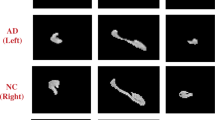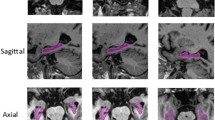Abstract
Feature representations extracted from hippocampus in magnetic resonance (MR) images are widely used in computer-aided Alzheimer’s disease (AD) diagnosis, and thus accurate segmentation for the hippocampus has been remaining an active research topic. Previous studies for hippocampus segmentation require either human annotation which is tedious and error-prone or pre-processing MR images via time-consuming non-linear registration. Although many automatic segmentation approaches have been proposed, their performance is often limited by the small size of hippocampus and complex confounding information around the hippocampus. In particular, human-engineered features extracted from segmented hippocampus regions (e.g., the volume of the hippocampus) are essential for brain disease diagnosis, while these features are independent of diagnosis models, leading to sub-optimal performance. To address these issues, we propose a multi-task deep learning (MDL) method for joint hippocampus segmentation and clinical score regression using MR images. The prominent advantages of our MDL method lie on that we don’t need any time-consuming non-linear registration for pre-processing MR images, and features generated by MDL are consistent with subsequent diagnosis models. Specifically, we first align all MR images onto a standard template, followed by a patch extraction process to approximately locate hippocampus regions in the template space. Using image patches as input data, we develop a multi-task convolutional neural network (CNN) for joint hippocampus segmentation and clinical score regression. The proposed CNN network contains two subnetworks, including 1) a U-Net with a Dice-like loss function for hippocampus segmentation, and 2) a convolutional neural network with a mean squared loss function for clinical regression. Note that these two subnetworks share a part of network parameters, to exploit the inherent association between these two tasks. We evaluate the proposed method on 407 subjects with MRI data from baseline Alzheimer’s Disease Neuroimaging Initiative (ADNI) database. The experimental results suggest that our MDL method achieves promising results in both tasks of hippocampus segmentation and clinical score regression, compared with several state-of-the-art methods.







Similar content being viewed by others
References
Abadi M, Barham P, Chen J, Chen Z, Davis A, Dean J, Devin M, Ghemawat S, Irving G, Isard M et al (2016) Tensorflow: A system for large-scale machine learning. In: Proceedings of the 12th USENIX symposium on operating systems design and implementation
Ahmed O B, Mizotin M, Benois-Pineau J, Allard M, Catheline G, Amar C B, Initiative A D N et al (2015) Alzheimer’s disease diagnosis on structural MR images using circular harmonic functions descriptors on hippocampus and posterior cingulate cortex. Comput Med Imaging Graph 44:13–25
Ashburner J (2007) A fast diffeomorphic image registration algorithm. NeuroImage 38(1):95–113
Barnes J, Boyes R, Lewis E, Schott J, Frost C, Scahill R, Fox N (2007) Automatic calculation of hippocampal atrophy rates using a hippocampal template and the boundary shift integral. Neurobiol Aging 28(11):1657–1663
Boyd S, Vandenberghe L (2004) Convex optimization. Cambridge University Press, Cambridge
Cao X, Gao Y, Yang J, Wu G, Shen D (2016) Learning-based multimodal image registration for prostate cancer radiation therapy. In: International Conference on Medical Image Computing and Computer-Assisted Intervention, Springer, pp 1–9
Cao X, Yang J, Gao Y, Guo Y, Wu G, Shen D (2017) Dual-core steered non-rigid registration for multi-modal images via bi-directional image synthesis. Medical Image Analysis
Carmichael O T, Aizenstein H A, Davis S W, Becker J T, Thompson P M, Meltzer C C, Liu Y (2005) Atlas-based hippocampus segmentation in Alzheimer’s disease and mild cognitive impairment. NeuroImage 27(4):979–990
Chang C C, Lin C J (2011) Libsvm: A library for support vector machines. ACM Trans Intell Syst Technol 2(3):27
Chincarini A, Bosco P, Calvini P, Gemme G, Esposito M, Olivieri C, Rei L, Squarcia S, Rodriguez G, Bellotti R et al (2011) Local MRI analysis approach in the diagnosis of early and prodromal Alzheimer’s disease. NeuroImage 58 (2):469–480
Clark K A, Woods R P, Rottenberg D A, Toga A W, Mazziotta J C (2006) Impact of acquisition protocols and processing streams on tissue segmentation of T1 weighted MR images. NeuroImage 29(1):185–202
Coupé P, Manjón J V, Fonov V, Pruessner J, Robles M, Collins D L (2011) Patch-based segmentation using expert priors: Application to hippocampus and ventricle segmentation. NeuroImage 54(2):940–954
Coupé P, Eskildsen S F, Manjón J V, Fonov V S, Collins D L (2012) Simultaneous segmentation and grading of anatomical structures for patient’s classification: Application to Alzheimer’s disease. NeuroImage 59(4):3736–3747
Dagher A, Owen A M, Boecker H, Brooks D J (2001) The role of the striatum and hippocampus in planning: A PET activation study in Parkinson’s disease. Brain 124(5):1020–1032
Dill V, Franco A R, Pinho M S (2015) Automated methods for hippocampus segmentation: The evolution and a review of the state of the art. Neuroinformatics 13 (2):133
Folstein M F, Folstein S E, McHugh P R (1975) “mini-mental state”. A practical method for grading the cognitive state of patients for the clinician. J Psychiatr Res 12(3):189–198
Hao Y, Wang T, Zhang X, Duan Y, Yu C, Jiang T, Fan Y (2014) Local label learning (LLL) for subcortical structure segmentation: Application to hippocampus segmentation. Hum Brain Mapp 35 (6):2674–2697
Heckemann R A, Hajnal J V, Aljabar P, Rueckert D, Hammers A (2006) Automatic anatomical brain MRI segmentation combining label propagation and decision fusion. NeuroImage 33(1):115–126
Hyman B T, Van Hoesen G W, Damasio A R, Barnes C L (1984) Alzheimer’s disease: Cell-specific pathology isolates the hippocampal formation. Science 225:1168–1171
Iglesias J E, Sabuncu M R (2015) Multi-atlas segmentation of biomedical images: A survey. Med Image Anal 24(1):205–219
Jack C R, Petersen R C, O’Brien P C, Tangalos E G (1992) MR-based hippocampal volumetry in the diagnosis of Alzheimer’s disease. Neurology 42(1):183–183
Jack C R, Bernstein M A, Fox N C, Thompson P, Alexander G, Harvey D, Borowski B, Britson P J, L Whitwell J, Ward C (2008) The Alzheimer’s disease neuroimaging initiative (ADNI): MRI methods. J Magn Reson Imaging 27(4):685–691
Jin K, Peel A L, Mao X O, Xie L, Cottrell B A, Henshall D C, Greenberg D A (2004) Increased hippocampal neurogenesis in Alzheimer’s disease. Proc Natl Acad Sci 101(1):343–347
Kwak K, Yoon U, Lee D K, Kim G H, Seo S W, Na D L, Shim H J, Lee J M (2013) Fully-automated approach to hippocampus segmentation using a graph-cuts algorithm combined with atlas-based segmentation and morphological opening. Magn Reson Imaging 31(7):1190–1196
Lian C, Ruan S, Denoeux T (2015) An evidential classifier based on feature selection and two-step classification strategy. Pattern Recogn 48(7):2318–2327
Lian C, Ruan S, Denœux T, Jardin F, Vera P (2016) Selecting radiomic features from FDG-PET images for cancer treatment outcome prediction. Med Image Anal 32:257–268
Lindner C, Thiagarajah S, Wilkinson J, Consortium T, Wallis G, Cootes T (2013) Fully automatic segmentation of the proximal femur using random forest regression voting. IEEE Trans Med Imaging 32(8):1462–1472
Liu M, Zhang D, Shen D (2015) View-centralized multi-atlas classification for Alzheimer’s disease diagnosis. Hum Brain Mapp 36(5):1847–1865
Liu M, Zhang D, Chen S, Xue H (2016) Joint binary classifier learning for ECOC-based multi-class classification. IEEE Trans Pattern Anal Mach Intell 38 (11):2335–2341
Liu M, Zhang D, Shen D (2016) Relationship induced multi-template learning for diagnosis of Alzheimer’s disease and mild cognitive impairment. IEEE Trans Med Imaging 35(6):1463–1474
Liu M, Zhang J, Yap P T, Shen D (2017) View-aligned hypergraph learning for alzheimer’s disease diagnosis with incomplete multi-modality data. Med Image Anal 36:123–134
Liu M, Zhang J, Adeli E, Shen D (2018) Landmark-based deep multi-instance learning for brain disease diagnosis. Med Image Anal 43:157–168
Moodley K, Minati L, Contarino V, Prioni S, Wood R, Cooper R, D’incerti L, Tagliavini F, Chan D (2015) Diagnostic differentiation of mild cognitive impairment due to Alzheimer’s disease using a hippocampus-dependent test of spatial memory. Hippocampus 25(8):939–951
Pohl K M, Bouix S, Nakamura M, Rohlfing T, McCarley R W, Kikinis R, Grimson W E L, Shenton M E, Wells W M (2007) A hierarchical algorithm for MR brain image parcellation. IEEE Trans Med Imaging 26(9):1201–1212
Ronneberger O, Fischer P, Brox T (2015) U-net: Convolutional networks for biomedical image segmentation. arXiv:150504597
Sled J G, Zijdenbos A P, Evans A C (1998) A nonparametric method for automatic correction of intensity nonuniformity in MRI data. IEEE Trans Med Imaging 17(1):87–97
Tulving E, Markowitsch H J (1998) Episodic and declarative memory: Role of the hippocampus. Hippocampus 8(3):198–204
Zandifar A, Fonov V, Coupé P, Pruessner J, Collins DL, Initiative ADN et al (2017) A comparison of accurate automatic hippocampal segmentation methods. NeuroImage
Zarpalas D, Gkontra P, Daras P, Maglaveras N (2014) Accurate and fully automatic hippocampus segmentation using subject-specific 3D optimal local maps into a hybrid active contour model. IEEE J Trans Eng Health Med 2:1–16
Zhang J, Liang J, Zhao H (2013) Local energy pattern for texture classification using self-adaptive quantization thresholds. IEEE Trans Image Process 22(1):31–42
Zhang J, Gao Y, Wang L, Tang Z, Xia J J, Shen D (2016) Automatic craniomaxillofacial landmark digitization via segmentation-guided partially-joint regression forest model and multiscale statistical features. IEEE Trans Biomed Eng 63(9):1820–1829
Zhang J, Gao Y, Park SH, Zong X, Lin W, Shen D (2017) Structured learning for 3D perivascular spaces segmentation using vascular features. IEEE Transactions on Biomedical Engineering
Zhang J, Liu M, An L, Gao Y, Shen D (2017) Alzheimer’s disease diagnosis using landmark-based features from longitudinal structural MR images. IEEE Journal of Biomedical and Health Informatics
Zhang J, Liu M, Shen D (2017) Detecting anatomical landmarks from limited medical imaging data using two-stage task-oriented deep neural networks. IEEE Trans Image Process 26(10):4753–4764
Zhu X, Suk H I, Shen D (2014) A novel matrix-similarity based loss function for joint regression and classification in AD diagnosis. NeuroImage 100:91–105
Zhu X, Suk H I, Wang L, Lee SW, Shen D (2015) A novel relational regularization feature selection method for joint regression and classification in AD diagnosis. Medical Image analysis
Zhu Y, Zhu X, Kim M, Shen D, Wu G (2016) Early diagnosis of Alzheimer’s disease by joint feature selection and classification on temporally structured support vector machine. In: International Conference on Medical Image Computing and Computer-Assisted Intervention, Springer, pp 264–272
Zhu Y, Zhu X, Zhang H, Gao W, Shen D, Wu G (2016) Reveal consistent spatial-temporal patterns from dynamic functional connectivity for autism spectrum disorder identification. In: International Conference on Medical Image Computing and Computer-Assisted Intervention, Springer, pp 106–114
Zhu Y, Zhu X, Kim M, Kaufer D, Wu G (2017) A novel dynamic hyper-graph inference framework for computer assisted diagnosis of neuro-diseases. In: International Conference on Information Processing in Medical Imaging, Springer, pp 158–169
Zou K H, Warfield S K, Bharatha A, Tempany C M, Kaus M R, Haker S J, Wells W M, Jolesz F A, Kikinis R (2004) Statistical validation of image segmentation quality based on a spatial overlap index 1: Scientific reports. Acad Radiol 11(2):178–189
Acknowledgments
This study was supported by National Natural Science Foundation of China (Nos. 61703301, 61573023) one more support grant and University Science and Technology Project of Shandong Province (No. J17KA086).
Author information
Authors and Affiliations
Corresponding author
Rights and permissions
About this article
Cite this article
Cao, L., Li, L., Zheng, J. et al. Multi-task neural networks for joint hippocampus segmentation and clinical score regression. Multimed Tools Appl 77, 29669–29686 (2018). https://doi.org/10.1007/s11042-017-5581-1
Received:
Revised:
Accepted:
Published:
Issue Date:
DOI: https://doi.org/10.1007/s11042-017-5581-1




